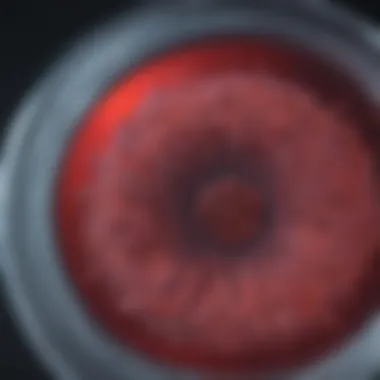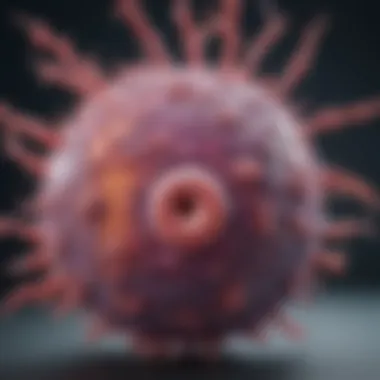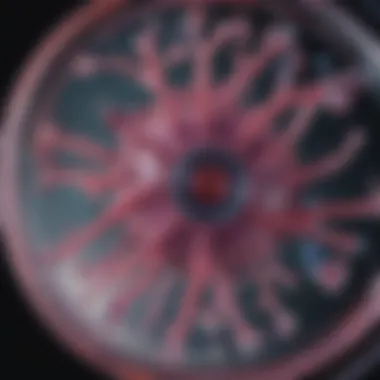Exploring CD138's Role in Immunology and Oncology


Intro
In the world of immunology and oncology, the intricacies of cell surface proteins are more than mere biological details; they often serve as linchpins of critical therapeutic interventions. One such protein is CD138, recognized for its pivotal role on plasma cells and select tumor cells. This article ventures into the profound implications of CD138, presenting a deep dive into its functions, its ties to various diseases, and exploring its promising therapeutic potentials.
The exploration of CD138 is not just a nuanced detailing of its biological attributes. It's about understanding how this protein intertwines with immune responses, particularly in the context of hematological malignancies like multiple myeloma. Recently, researchers have started to fill in the gaps regarding how CD138 functions within these disease processes, shedding light on its significance in both diagnosis and treatment.
As we embark on this examination, it becomes crucial to highlight several key components. First, we will outline the core findings in recent research, demonstrating why CD138 warrants attention across both fields. Subsequently, we will delve into the methodologies employed in current studies, understanding how scientists assemble the puzzle pieces surrounding CD138's role. Every detail is important as they contribute to a larger understanding that could revolutionize approaches to therapies targeting this protein.
With this framework, our reader will not only grasp the essentials of CD138 but also appreciate its broader implications in the scientific community and beyond.
Prologue to CD138
Understanding CD138 is crucial, as it serves many important functions in the realm of immunology and oncology. This protein goes by several names—syndecan-1 being the most recognized—but what remains consistent is its role in plasma cell biology and disease pathology. This section will introduce CD138 by defining its basic structure and tracing its historical context, providing a solid foundation for further exploration.
Definition and Basic Structure
CD138 is a cell surface glycoprotein primarily found on plasma cells. This protein is categorized as a member of the syndecan family, which are known for their ability to interact with extracellular matrix components and various ligands involved in cell signaling. Structurally, CD138 consists of three key components: a short cytoplasmic domain, a single transmembrane region, and an extracellular domain boasting multiple glycosaminoglycan (GAG) chains. These GAG chains are significant, because they enable CD138 to engage with various signaling molecules, effectively influencing both cellular behavior and communication.
Moreover, the extracellular domain of CD138 grants it a unique position in the immune system, particularly by supporting the interactions between plasma cells and other components of the hematopoietic system. It acts like a bridge, allowing communication with surrounding cells. The importance of this functionality becomes more evident when considering the role of plasma cells in producing antibodies—without CD138, this process would be severely disrupted.
Historical Background
The exploration of CD138 began in earnest during the late 1980s and early 1990s. Initially discovered through studies focused on plasma cells, researchers identified its significance in cell adhesion and migration. Its role quickly expanded beyond mere identification; it became clear that CD138 was integral to the immune response and disease processes.
As research progressed, the connection between CD138 and hematological malignancies emerged. By the mid-1990s, evidence suggested that this protein was not merely a passive participant but played an active role in the pathogenesis of diseases like multiple myeloma. This marked a pivotal turning point in the understanding of both CD138 and plasma cell biology.
In recent years, the momentum has only increased. Investigations into CD138 have revealed its implications in various cancers, establishing it as a pivotal target for therapies like monoclonal antibodies, such as daratumumab, which has demonstrated success in treating specific leukemias. Understanding the history and evolution of CD138 research deepens our comprehension of the current therapeutic strategies involving this protein, signalling a promising avenue for both investigation and clinical practice in immunology and oncology.
The Biological Role of CD138
Understanding the biological role of CD138 reveals its complexity and significance in the immune system and oncology. As a cell surface glycoprotein, CD138, or Syndecan-1, is chiefly located on plasma cells, providing insights into immune dynamics. Detecting the expression patterns and functional activities of CD138 not only enhances our understanding of plasma cell biology but also sheds light on its role in various diseases, especially cancers.
Expression Patterns in Immune Cells
CD138’s expression varies widely across different immune cell types, primarily being affiliated with terminally differentiated plasma cells. Its presence in these cells aids in the recognition of their role within the immune response. Researchers have shown that CD138 expression can serve as an indicator of plasma cell differentiation and function.
In addition, it’s worth noting that the expression of CD138 is not limited to plasma cells. Some T cells also exhibit CD138 expression under specific conditions, particularly during immune responses where differentiation and activation occur. This variability can indicate how these cells interact within the immune environment. The upsurge of CD138 expression correlates with some signaling pathways that stimulate cell activation, highlighting its potential role in regulating these responses.
Function in Plasma Cell Biology
Plasma cells are crucial in the production of antibodies, and CD138 serves a multifunctional role in this process. It acts as a receptor that binds to certain extracellular matrix components, which is essential for the retention of plasma cells in the bone marrow. This retention is vital for maintaining antibody production over prolonged periods.


Moreover, CD138 influences the survival and proliferation of plasma cells. When activated, it triggers signaling cascades that help plasma cells endure under varying conditions. Understanding CD138's roles can provide insights into immune deficiencies where plasma cell function is impaired.
"The capacity of CD138 to modulate interactions between plasma cells and their surroundings is fundamental for long-term immunity."
Signaling Pathways Involving CD138
CD138 is entwined with numerous signaling pathways that facilitate plasma cell function. One significant pathway is the interaction between CD138 and heparin-binding growth factors. This engagement essentially supports cell survival and proliferation by triggering downstream signaling mechanisms that activate survival pathways.
In the context of disease, aberrations in these pathways can lead to unregulated plasma cell proliferation seen in multiple myeloma. By dissecting these signaling routes, researchers can unveil potential therapeutic avenues targeting these aberrant pathways. Furthermore, understanding how CD138 participates in cell signaling can inform strategies for manipulating immune responses in vaccination or immunotherapy settings.
In summary, the biological role of CD138 is indispensable in both normal and pathological contexts. Its differential expression among immune cells, crucial function in plasma cell survival and antibody production, and involvement in complex signaling pathways underscore its relevance. Delving into CD138 leads to richer knowledge that could refine therapeutic approaches in immunology and oncology alike.
CD138 in Health and Disease
The investigation of CD138 offers important insights into both normal physiological processes and a variety of pathological conditions. It serves as a critical marker in immunology, particularly regarding plasma cells and certain tumor cells. Understanding its role in health is essential to appreciate how its dysfunction or abnormal expression can lead to disease, including various hematological malignancies.
Role in Normal Immune Function
In a healthy immune system, CD138 is prominently located on the surface of plasma cells, the immune cells responsible for producing antibodies. This protein plays a pivotal role in the secretion of immunoglobulins, crucial for immune defense. When activated, these plasma cells proliferate and differentiate, contributing to the body's ability to fight off infections. CD138's presence ensures that a robust immune response is generated, enabling the body to maintain homeostasis.
Moreover, recent studies suggest that CD138 also has roles in cell adhesion and migration. By supporting interactions between plasma cells and their microenvironment, it ensures that these crucial cells remain localized where they are needed most, such as lymph nodes or the bone marrow, enhancing immune responses effectively.
CD138 and Hematological Malignancies
When looking into the shadows of the immune landscape, one can't overlook CD138's crucial implications in hematological malignancies. Elevated expressions of CD138 have been associated with multiple myeloma, a blood cancer arising from malignant plasma cells. In this condition, CD138 becomes an important diagnostic marker, helping clinicians ascertain the disease's presence and prognosis.
It doesn’t stop there—research delves into the intricate relationship between CD138 and other hematological cancers, like Waldenström's macroglobulinemia. The findings indicate that CD138 expression might not only assist in diagnosis but also in understanding the disease's biology, offering pathways for tailored therapies.
Implications in Myeloma
Focusing specifically on multiple myeloma, the expression of CD138 provides valuable information on tumor biology. High levels of CD138 are characteristic of malignant plasma cells, marking their aggressiveness and therapeutic resistance. This observation has led to the development of strategies targeting CD138, such as monoclonal antibodies, which aim to obliterate myeloma cells while sparing normal cells. The goal is to enhance patient response to treatment while minimizing side effects.
Furthermore, CD138 also seems to link with several pathways that contribute to myeloma's pathogenesis. It is intertwined with factors that regulate cell growth and survival, fostering a niche that can support tumor progression. Addressing CD138 in therapeutic interventions could therefore hold the key to better clinical outcomes.
Involvement in Other Cancers
Beyond hematological malignancies, findings suggest that CD138 may have roles in solid tumors as well. For instance, some studies indicate that CD138 expression is noteworthy in breast and lung cancers, where it may correlate with tumor aggressiveness and poor prognosis. This observation emphasizes that CD138 is not merely a plasma cell marker but potentially could aid in understanding various cancer biology, thus broadening its therapeutic landscape.
In summary, the assessment of CD138 provides a dual lens on health and disease. By evaluating its roles in normal immune function and its implications in hematological malignancies and other cancers, it brightens our understanding of immune responses and disease pathology alike. As research continues, the hope is that insights gleaned from CD138 will prove fruitful in formulating targeted therapies and improving clinical practices for a broader spectrum of diseases.
Therapeutic Targeting of CD138
Targeting CD138 therapeutically has gained considerable traction in recent years, reflecting its significance as a protein associated with plasma cell neoplasms and certain solid tumors. The rationale behind this therapeutic focus stems from the unique expression patterns of CD138, which, when targeted, can enable enhanced precision in treatment. Given its pivotal role in immune responses and its implication in various cancers, understanding the nuances of CD138 targeting not only augments the therapeutic landscape but may also lead to improved patient outcomes. This section delves into the main avenues for targeting this molecule, including monoclonal antibodies, CAR T-cell therapies, and combination strategies.


Monoclonal Antibodies Against CD138
Monoclonal antibodies such as daratumumab have emerged as frontline therapies for multiple myeloma, targeting CD138 to orchestrate targeted destruction of malignant cells. These antibodies can bind specifically to CD138, prompting an immune-mediated attack against plasma cells. Notably, they can exert several mechanisms, including complement-mediated lysis and antibody-dependent cellular cytotoxicity.
This targeted approach presents numerous advantages:
- High Specificity: Since CD138 is primarily expressed on plasma cells, therapies targeting it are less likely to affect other cell types significantly.
- Durable Responses: Some patients have experienced prolonged remissions, implying that CD138 monoclonal antibodies could be integral to maintaining long-term disease control.
However, it is also crucial to consider potential challenges such as the emergence of resistance and the development of anti-drug antibodies, which may limit the efficacy and safety of these therapies. Close monitoring and studies to mitigate these issues are underway.
CAR T-Cell Therapies Targeting CD138
Chimeric Antigen Receptor (CAR) T-cell therapies represent a promising frontier in immunotherapy by equipping T cells with receptors that specifically target CD138 on tumor cells. This innovative approach harnesses the body’s immune system to selectively destroy malignant plasma cells, particularly beneficial in relapsed or refractory cases.
The impact of CAR T-cell therapies could include:
- Enhanced Tumor Elimination: These engineered T cells can migrate to the tumor microenvironment, offering a direct means of targeting and killing CD138-expressing cells.
- Personalized Treatment: The ability to customize CAR T-cell designed for each patient opens a door to personalized medicine, tailoring interventions based on individual tumor profiles.
On the flip side, the risks of cytotoxicity and severe inflammatory responses need careful oversight, highlighting the need for well-established protocols to ensure patient safety.
Combination Therapies Involving CD138
Combining CD138-targeted therapies with other treatment modalities is gaining increased attention. For instance, pairing monoclonal antibodies with immunomodulatory drugs or chemotherapy may result in synergistic effects. These combination strategies can enhance efficacy by tackling cancer from multiple angles, possibly resulting in better overall survival rates.
Such combinations might include:
- Monoclonal Antibodies + Immunomodulators: This avenue seeks to enhance immune responses and tackle drug resistance.
- Targeted Therapy + Chemotherapy: This combination aims to inhibit tumor survival while also inducing cell death through traditional chemotherapy agents.
"Innovation in therapeutic strategies involving CD138 may pave the way for breakthroughs in treating hematological malignancies."
In summary, the therapeutic targeting of CD138 provides a multi-faceted approach to combat cancers associated with this protein. Whether leveraging monoclonal antibodies, CAR T-cell technologies, or combination methods, ongoing research and clinical tests will shape the future landscape of treatments available for patients, ultimately aiming for more refined and effective protocols.
Detection and Analysis of CD138
Understanding the detection and analysis of CD138 is crucial for both research and clinical applications. As a marker prevalent on plasma cells and certain neoplastic cells, the ability to accurately detect CD138 allows scientists and clinicians to assess its expression levels, which can be indicative of various pathological states. This knowledge is not only relevant for diagnosis but also for monitoring disease progression and response to therapies.
In an evolving field like immunology and oncology, pinpointing where and how CD138 functions can lead to new insights. Its unusual presence in hematological malignancies emphasizes the need for precise detection methods. In addition, understanding the nuances of CD138 expression can help tailor treatments for patients, enhancing therapeutic effectiveness by targeting the right cells at the right times.
Techniques for CD138 Detection
When it comes to detecting CD138, a variety of techniques are at researchers' disposal. Some of the commonly employed methods include:
- Flow Cytometry: a powerful tool that uses lasers to detect fluorescently labeled cells.
- Immunohistochemistry: a method that employs antibodies to visualize the presence of CD138 within tissue sections.
- Western Blotting: another analytical technique used to detect specific proteins, including CD138, in complex samples.


Every technique has its strengths and weaknesses. Flow cytometry stands out for its quantitative capabilities, while immunohistochemistry allows for the localization of CD138 within tissues, providing excellent spatial context.
Flow Cytometry and Immunohistochemistry
Flow cytometry is like having a backstage pass to the cellular world. It enables the simultaneous measurement of multiple parameters of thousands of cells per second. Using fluorescently tagged antibodies specific to CD138, one can effectively interrogate the expression on the cell surface. This method is beneficial for assessing a heterogeneous population of cells, such as those found in bone marrow samples from patients with multiple myeloma.
On the flip side, immunohistochemistry holds its ground by enabling one to visualize CD138 expression in situ, preserving the architecture of the tissue. This approach uses antibodies that bind specifically to CD138, followed by a secondary antibody linked to an enzyme or a fluorescent marker for detection. While flow cytometry provides quantifiable data, immunohistochemistry adds depth, allowing pathologists to determine not just if CD138 is present, but also where it is found within the tissue structure.
Both methodologies are indispensable and can even be complementary in clinical and research settings. After all, the aim is to understand the biological landscape surrounding CD138, making sound detection and analysis pivotal.
"In the realm of immunology and oncology, detection is not merely a preliminary step; it's a gateway to understanding the intricate dance of cellular interactions and therapeutic responses."
To sum up, the detection and analysis of CD138 provide insightful layers to its biological role in both health and disease, enhancing not just scientific understanding but also guiding clinical interventions.
Future Directions in CD138 Research
The exploration of CD138 is entering an exhilarating chapter where potential advancements in research and therapies can significantly reshape our understanding of immunology and oncology. This segment is crucial, as it delves into the pressing research gaps and the potential for innovative therapeutic avenues that can emerge from a deeper investigation into CD138's role. By recognizing unmet needs and emerging opportunities, researchers can pave the way for breakthroughs that enhance patient care and therapeutic efficiency.
Research Gaps and Opportunities
Despite the substantial progress made in understanding CD138's functions, several pertinent research gaps remain. Identifying these gaps opens avenues for exploration that could yield novel insights. Notably, we might explore the following:
- Role in Early Hematological Lesions: Investigating how CD138 is expressed in the initial stages of plasma cell and other hematological malignancies could provide insights into early diagnosis, potentially changing therapeutic trajectories.
- Interaction with Microenvironment: The tumor microenvironment plays a vital role in cancer progression. Researching how CD138 interacts with surrounding cells and extracellular matrix proteins can improve our understanding of tumor behavior and treatment responses.
- Mechanisms of Resistance: Exploring the mechanisms by which CD138-expressing tumors develop resistance to current therapies is crucial. Such insights could help design adjunctive treatments that preemptively address potential resistance.
- Cross-Talk with Immune Pathways: Understanding how CD138 might modulate or interact with various immune signaling pathways can provide valuable knowledge for enhancing immune responses against tumors.
"Identifying gaps in our understanding of CD138 not only shapes future investigation but also creates a pathway to potentially life-enhancing therapies."
The industry must capitalize on these opportunities, focusing efforts on targeted research initiatives that could fill these gaps. Collaborative platforms between academia and industry could accelerate the discovery of novel solutions that directly benefit clinical outcomes.
Potential for New Therapeutic Approaches
The therapeutic landscape surrounding CD138 is rife with possibilities for innovation. The potential to tap into new therapeutic approaches stems from a comprehensive analysis of CD138's biological functions and interactions.
- Novel Monoclonal Antibodies: While existing therapies utilize monoclonal antibodies against CD138, the development of next-generation antibodies may enhance specificity and reduce off-target effects. Tailored modifications to existing drugs could optimize their binding affinity, leading to more effective outcomes.
- Combination Strategies: Synergizing CD138-targeted therapies with other treatments—like immune checkpoint inhibitors or targeted therapies—could create comprehensive treatment regimens that maximize anti-tumor activity while minimizing side effects.
- Advanced Cell Therapies: Engineering more robust CAR T-cell therapies that target CD138 could improve responses in patients who have previously shown limited responsiveness to standard treatments. Research into optimizing T-cell design will be essential in this pursuit.
- Biomarker Discovery: Investigating additional biomarkers related to CD138 expression could lead to personalized therapeutic strategies, ensuring patients receive treatments that align specifically with their tumor profiles.
In summary, focusing on future research directions surrounding CD138 can foster substantial evolvement of both our fundamental understandings and therapeutic practices. By identifying the gaps in current research and exploring the potential new strategies, we can significantly advance both immunology and oncology, ultimately improving patient outcomes.
Ending
In summation, CD138 emerges as a considerable focal point within immunology and oncology, illustrating its dual role in both physiological and pathological contexts. The variability in CD138 expression across different cell types highlights its significance in normal immune function while also revealing its potential involvement in disease mechanisms. Understanding the nuances of CD138 can enhance our grasp of hematological malignancies and provide pathways for innovative therapeutic strategies.
Summary of Key Points
- Critical Function: CD138 plays a pivotal role primarily in plasma cell biology, influencing antibody production and immune memory.
- Disease Associations: Its expression is notably associated with various cancers, particularly multiple myeloma, underscoring its relevance in pathophysiology.
- Therapeutic Target: The targeting of CD138 through monoclonal antibodies and CAR T-cell therapies illustrates its potential in modern cancer treatments.
- Detection Techniques: Understanding detection methods, such as flow cytometry and immunohistochemistry, is crucial for identifying CD138 in clinical settings.
- Research Gaps: Identifying areas where knowledge is limited can lead to significant advances in both research and clinical applications.
Implications for Clinical Practice
The implications of CD138 in clinical practice are multi-faceted and profound. Given its pivotal role in plasma cell neoplasia, effectively targeting CD138 can improve treatment outcomes for patients with multiple myeloma. By utilizing specific anti-CD138 therapies, clinicians may enhance patient responses and potentially reduce side effects associated with broader-spectrum treatments. Furthermore, understanding the variability in CD138 expression can guide personalized therapeutic strategies, tailoring interventions to suit individual patient profiles.
Such insights can also drive future research endeavors, possibly leading to novel applications in other malignancies where CD138 expression is noted. In essence, the journey of CD138 in both research and clinical settings is far from over; it holds the promise of not just addressing current challenges in treatment but also paving the way for groundbreaking advancements in combating various cancers.







